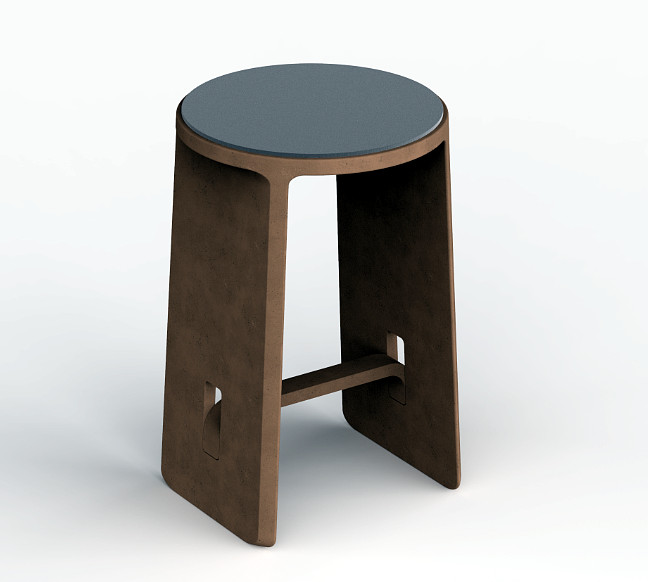As we move from climate change to climate crisis, it's increasingly important
for all industries to identify the solutions they can bring to our current state
of ‘broken nature.’ When designers and manufacturers innovate with this aim in
mind, numerous possibilities unfold — such as chairs and stools made from
mushrooms, recovered waste and even fishing nets collected from the ocean.
Over the last six months, thousands of people have discovered how design can be
leveraged to repair the humanitarian and environmental crisis facing our world
today at the XXII International Exhibition of La Triennale di
Milano. Curated by MoMA’s Paola Antonelli,
the exhibition — titled “Broken Nature: Design
Takes on Human Survival” — features works from over 25 countries. The USA
Pavilion was conceived and developed by a group of passionate environmental
advocates including Humanscale, Arup, MIT’s SHINE program,
Novità Communications, NextWave
Plastics,
the Green Building Alliance and Stickbulb. Open through September 1,
2019, the pavilion, titled RECKONstruct,
spotlights the materials revolution underway in the US, and documents how the
design studio of Humanscale — a leading workplace furnishings manufacturer —
reimagined a simple stool through three different approaches to sustainability.
As Chief Sustainability Officer at Humanscale, I
challenged our team of designers to think critically about how we can utilize
sustainability as the source of innovation for this project. In response, the
team developed three unique stools using naturally grown materials
(bio-fabrication), harvesting unused waste (circular
economy) and
mimicking nature’s engineering solutions
(biomimicry).
To measure the sustainability of each of the three designs, we partnered with
the Massachusetts Institute of Technology’s SHINE program, a research center
dedicated to improving the scientific basis by which Net
Positive
— or the movement to do more good than harm — is assessed across products,
activities, companies, economic sectors, individuals and groups (SHINE stands
for the Sustainability and Health Initiative for NetPositive Enterprise).
Using a comprehensive Life Cycle Assessment (LCA) — which confirms and
quantifies the land, climate, water and energy impacts for the entire design &
production process; from materials sourcing to transportation to manufacturing
to actual use — SHINE evaluated all three stool designs. Ultimately, each stool
was measured for its environmental “footprint” and
“handprint,”
or how it can have a positive environmental impact.

The first stool is inspired by the Venus’ Flower
Basket, a deep sea
sponge. The design team worked closely with Lindsay James, professor in the
Biomimicry Centre at Arizona State
University.
Thanks to 3D printing, they produced a light, comfortable stool that utilizes 24
percent less water, 99 percent less GHG emissions and 4.3 kg less waste,
compared to traditional manufacturing methods. The designer, Jacob Turetsky,
noted that “this stool would not have been possible without advancements in
additive manufacturing. The ability to create complex shapes using only the
material we need, based on lines of code we can download anywhere in the world,
would be an interesting response to some of the wasteful practices we see
today.”

Next, the Ciclo Stool was developed with UBQ
Materials — upcycled, thermoplastic composites, or
material traditionally destined for landfills — for the molded stool bottom, and
felted, discarded textiles to make the seat cushion. My colleague, Sergio
Silva, strategically chose UBQ material for its versatility and accessibility,
two elements that make it a feasible option for future designs. The LCA
determined that this stool uses 21 percent less water, 94 percent less GHG
emissions, and 4.65 kg less waste.

Lastly, the Root Stool utilizes biofabrication. Paul Sukphisit worked
alongside experts at Ecovative to create a stool
made of
mycelium,
the root structure of mushrooms. Mycelium grows between hemp fibers to create
composite blocks, which are arranged in the shape of the stool. The mycelium
continues to grow, bonding the blocks together to create sustainable foams and
more. This stool design utilizes 28 percent less water and 77 percent less GHG
emissions than a traditionally manufactured stool, and is 100 percent
compostable. This approach had its specific challenges that the designers
creatively worked around. As Paul shared, “There is thickness and size
limitation [with naturally grown materials], and it also needs to be in a
controlled environment to grow effectively.”
If we integrate these new approaches into the design process from the start, the
results are much more effective, and it shows that these resources have a clear
place in future design. Already, it’s uplifting to think about the tangible
efforts with new approaches to sustainable design that are already in motion.
Thanks to cross-industry collaborative initiatives such as NextWave, companies
across industries — including Dell, HP, Humanscale, Herman Miller,
GM, Interface, Bureo and Trek — are working together to fight
marine plastic at an industrial scale through a distribution web that repurposes
plastic before it ever reaches the ocean.
From alternative materials to new methods of production that support a circular
economy, sustainable design continues on a viable path forward and is an
approach that I hope other manufacturers embrace as the ultimate design
challenge.
Get the latest insights, trends, and innovations to help position yourself at the forefront of sustainable business leadership—delivered straight to your inbox.
Published Aug 27, 2019 7am EDT / 4am PDT / 12pm BST / 1pm CEST